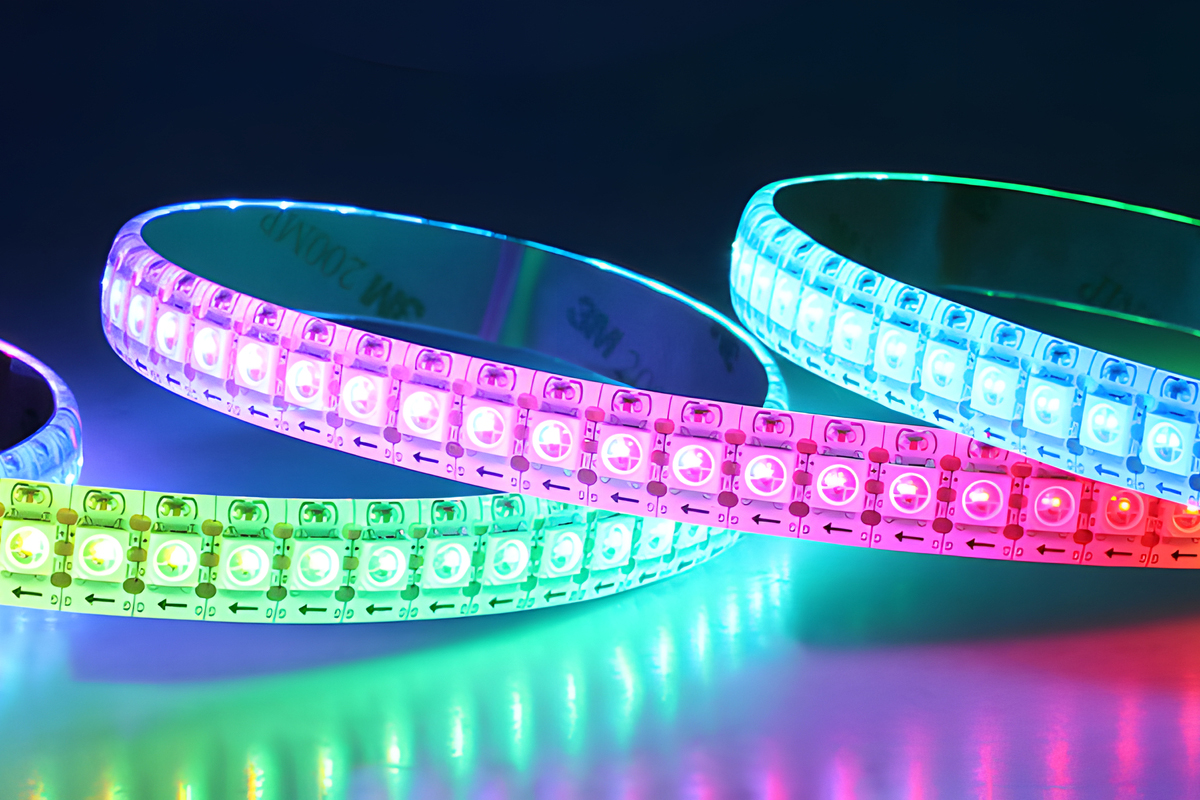Table of Contents Hide

What is an individually addressable LED strip light
An individually addressable LED strip light is a digital linear LED array that uses smart, mini LED light engines to create dynamic lighting effects, color animations, and patterns by programming the behavior of each light engine independently. These LED light engines are referred to as addressable LEDs. Individually addressable LED strip lights have gained immense popularity due to their versatility, programmability, and ability to provide unique and dynamic lighting experiences across various applications.Addressable LED lighting
The term "addressable" implies that each LED chip or package in the system has a unique address, and commands can be sent to specific LEDs, making it possible for precise control over color, brightness, and dynamic lighting effects. Adjusting the relative intensities of different color channels of an LED color mixing system changes the overall spectral power distribution (SPD) and, consequently, the perceived color. Adjusting the relative intensities or colors of different addressable LEDs allows for the creation of dynamic lighting effects, color animations, and patterns across the entire run of an LED strip. Whereas in non-addressable LED strips, all LEDs share the same color and brightness settings and controlled as a group rather than individually.Addressable LEDs
An addressable LED is a package-scale LED light engine that incorporates LEDs and a driver. The driver typically includes an integrated circuit (IC) or controller chip to manage data communication, interpret control signals, managing power distribution, and controlling the individual LED channels. Microcontrollers, such as Arduino or Raspberry Pi, are often used to control addressable LEDs via a communication protocol. They can execute complex lighting programs through the use of software or pre-built libraries. This enables users to create dynamic lighting effects, which can include color transitions, chasing, fading, strobing, and synchronization with external stimuli. The LED driver receives data input in a specific format, following a communication protocol. In addition to data input, there are control pins for power supply connections, ground, and sometimes additional features like a clock signal.Communication protocol
The communication protocol is a set of rules that defines how data is transmitted and received between the microcontroller and the LED driver. Common protocols for individually addressable LED strips include one-wire protocols and SPI (Serial Peripheral Interface). The one-wire digital communication protocol allows data to be sent serially to each LED in the strip, specifying the color and brightness individually. A single data line carries information for all LEDs in a chain. SPI uses separate data and clock lines, offering benefits such as higher refresh rates and providing precise control. WS2812, WS2812B, WS2813, WS2815, SK9822, SK6812 and SK6813 use one-wire protocols, while WS2801, APA102, APA102C, SK9822 and LPD8806 uses SPI.LED controller
Addressable LED strips require a microcontroller or a dedicated LED controller to send data signals and instructions to each control channel. Some common types of microcontrollers for individually addressable LED strips are Arduino, Raspberry Pi, ESP8266, and ESP32. Arduino is a popular open-source electronics platform that provides a versatile and programmable solution for various lighting applications. Arduino and addressable LEDs, such as WS2812, WS2812B (NeoPixel), APA102, SK6812, and others, can be combined to create interactive electronic projects. Common Arduino board models include Arduino Uno, Arduino Nano, Arduino Mega, etc. Raspberry Pi is a single-board computer capable of more complex tasks and applications. ESP8266 and ESP32 are Wi-Fi-enabled microcontrollers suitable for IoT applications.There are standalone LED controllers, such as SP105E and SP108E that can work with various individually addressable LED strips. They often support multiple protocols and offer features like Bluetooth connectivity for mobile app control. T1000S, T8000 series are popular LED controllers with a range of functions and compatibility with different LED strip protocols including WS2811, WS2812, WS2812B, TM1803, TM1804, TM1809, TM1812, UCS1903, UCS1912, UCS2903, UCS2909, and more.




































